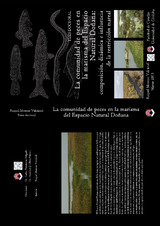La comunidad de peces en la Marisma del Espacio Natural de Doñana: composición, dinámica y efectos de la restricción mareal
Autor
Moreno Valcárcel, Raquel
Director/es
Fernández-Delgado, CarlosOliva Paterna, Francisco José
Editor
Universidad de Córdoba, UCOPressFecha
2015Materia
IctiofaunaIcthyofauna
Parque Nacional de Doñana
Doñana National Park
Parque Natural de Doñana
Doñana Natural Park
Área Natural protegida de Doñana
Doñana Natural Protected Area
Marismas de Doñana
Doñana Marhlands
METS:
Mostrar el registro METSPREMIS:
Mostrar el registro PREMISMetadatos
Mostrar el registro completo del ítemResumen
Estuaries and marshlands are regarded as one of the most productive and
threatened ecosystems in the world. A diverse community of organisms inhabits
these areas that are able to cope with the natural variability characteristic of these
tidal areas. Specifically, marshlands are considered important habitats for fishes
due to their important role in the different aspects of their lives, such as feeding,
reproduction, nursery grounds and pathways for migration.
Those zones provide a wide range of goods and services to humans, such as
natural protection of the coast against storms and floods, maintenance of water
quality, water detoxification and filtering, support for tourism and other cultural
and spiritual activities, etc. Additionally, marshlands are considered among the
most productive ecosystems due to high nutrient concentrations and efficient
energy cycling, and high biological productivity provides an abundance of food
resources. The areas adjacent to marshlands are important navigation routes,
therefore, marshlands and estuaries have historically been the most populated
zones in the world. In spite of all the services that estuarine areas provide to
human beings, these areas are under a great deal of human pressure that notably
affects their functions and characteristics, and currently estuarine zones are
among the most heavily used and threatened natural systems globally.
During long periods in history, wetlands have been considered unhealthy and
dangerous places, and humans have tended to dry and transform these lands, using
them mainly as croplands. Fortunately, this perception has changed in the last few
years and humans have realized that the loss and decline of these wetlands
reduces their ability to produce goods and services for mankind. Estuarine areas
suffer other important stressors now, such as the introduction of exotic species...
Colecciones
Ítems relacionados
Mostrando ítems relacionados por Título, autor o materia.
-
Análisis polínico de mieles en el Parque Natural de Doñana
Andrés, C.; Díez, M.J.; Terrab, A. (Universidad de Córdoba, Departamento de Biología Vegetal y Ecología; Asociación de Palinólogos de Lengua Española, 2006) -
Consideraciones sobre el concepto natural en San Pablo
López Bravo, Carlos (UCOPress, 2002)El concepto de ley natural reflejado en los dos primeros capítulos de la Carta de San Pablo a los Romanos, significa, en la historia de la Filosofía jurídica, el nacimiento de un nuevo iusnaturalismo, que con raíces en el ... -
Paisaje, patrimonio y turismo de surf: factores de atracción y motivación en el "Parque Natural del Estrecho" (España)
Rivera Mateos, Manuel (Universidad de Murcia, 2016)En este trabajo se estudia la incidencia de diversos factores geográficos, físico-ambientales, paisajísticos y socioculturales en la conformación y desarrollo de un destino especializado en turismo deportivo de naturaleza ...

